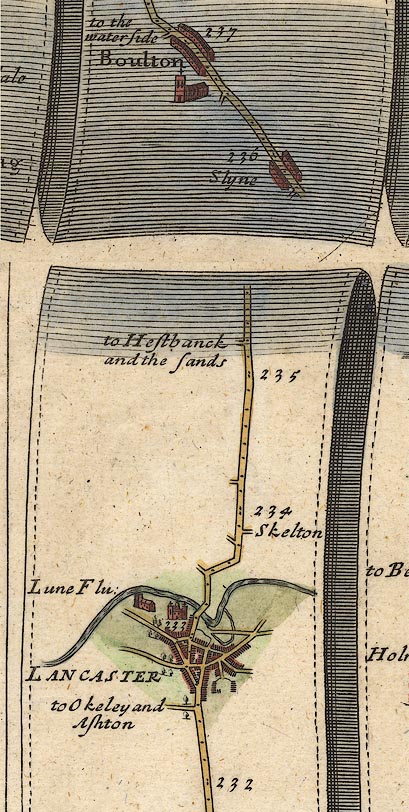 |
 |
   |
|
|
| site name:- |
Lune, River |
| locality:- |
Lancaster |
| county:- |
Lancashire |
| locality type:- |
bridge |
| coordinates:- |
SD475622 |
| 1Km square:- |
SD4762 |
| 10Km square:- |
SD46 |
|
|
| evidence:- |
probably old map:- Ogilby 1675 (plate 38)
|
| source data:- |
Road strip map, hand coloured engraving, continuation of the
Road from London to Carlisle, scale about 1 inch to 1 mile, by
John Ogilby, London, 1675.

OG38m232.jpg
In mile 233, Lancashire.
Road crosses:- "Lune Flu:"
no bridge drawn.
item:- JandMN : 21
Image © see bottom of page
|
|
|
| evidence:- |
descriptive text:- West 1778 (11th edn 1821)
item:- coin, danish
|
| source data:- |
Guide book, A Guide to the Lakes, by Thomas West, published by
William Pennington, Kendal, Cumbria once Westmorland, and in
London, 1778 to 1821.
 goto source goto source
Page 24:- "... When the present incommodious bridge was lately repaired, some brass pieces of
money were met with under a foundation stone, from which it was conjectured to be
of Danish origin. A more ancient bridge stood higher up the river, at Skerton town
end: an eligible situation for a new one, which would make a fine and convenient entrance
into Lancaster, from the north, and which at present on many accounts it much wants
[1]."
|
|
|
| evidence:- |
old map:- Yates 1786
|
| source data:- |
Map, engraving, The County Palatine of Lancaster, scale about 1
inch to 1 mile, by William Yates, published, London, 1786.
|
|
|
| evidence:- |
descriptive text:- Otley 1823 (8th edn 1849)
|
| source data:- |
Guide book, A Concise Description of the English Lakes, the
mountains in their vicinity, and the roads by which they may be
visited, with remarks on the mineralogy and geology of the
district, by Jonathan Otley, published by the author, Keswick,
Cumberland now Cumbria, by J Richardson, London, and by Arthur
Foster, Kirkby Lonsdale, Cumbria, 1823; published 1823-49,
latterly as the Descriptive Guide to the English Lakes.
 goto source goto source
Page 170:- "..."
"Bridges.- The Bridge which formerly spanned the Lune, near the present quay, was of
very ancient origin. It has been supposed to be coeval with the sojourn here of the
Romans. Other topographers give the Danes the credit for it. There our Saxon ancestors,
in a recess supported by projecting rows of corbels, sat, it has been"
 goto source goto source
Page 171:- "said, to administer justice. Its remains, with its broken arches, formed a beautiful
specimen of antiquity. It has now, however, entirely disappeared. ..."
|
|
|






 goto source
goto source goto source
goto source goto source
goto source